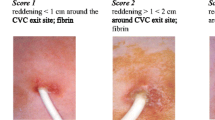Abstract
Five hundred two central venous catheters inserted in 366 patients were evaluated prospectively over a one-year period to determine the frequency and risk factors associated with catheter-related sepsis. For study purposes, in cases in which catheter infection was suspected but the initial blood cultures were negative, the catheters were replaced by guidewire technique; otherwise, the catheters were routinely changed after 21 days by guidewire technique. A catheter-related infection was suspected in 190 cases (190/502, 38%). A diagnosis of catheter-related sepsis was established in 50 patients, which represents 10% of the total number of lines (502). Over a total of 6428 days of catheter use, the infection rate was 0.8 cases of sepsis per 100 catheter-days.Staphylococcus epidermidis, Staphylococcus aureus, andCandida spp. were the most frequently isolated aetiological agents of sepsis. On univariate analysis, six variables affecting the rate of catheter-related sepsis were identified: neutropenia for more than eight days (p<0.001); AIDS (p<0.001); haematological malignancy (p<0.001); administration of total parenteral nutrition (p=0.001); duration of site use (p=0.04); and high APACHE II score (p=0.04). The logistic regression analysis revealed that AIDS and haematological malignancies were independent risk factors of catheter-related sepsis. Catheter replacement over a guidewire was no more likely to be associated with sepsis than was percutaneous catheter insertion. In conclusion, although the incidence of established catheter infection is much lower than the incidence of suspected infection, in most cases of suspected infection it is wise to change the catheter with the guidewire technique and wait for culture of the tip, rather than to remove the catheter immediately. Such a policy may help reduce the number of unnecessary catheter removals.
Similar content being viewed by others
References
Collignon PJ: Intravascular catheter-associated sepsis: a common problem. Medical Journal of Australia 1994, 161: 374–378.
Gosbell IB: Central venous catheter-related sepsis: epidemiology, pathogenesis, diagnosis, treatment and prevention. Intensive Care World 1994, 11: 54–58.
Norwood S, Ruby A, Civetta J, Cortes V: Catheter related infections and associated septicemia. Chest 1991, 99: 968–975.
Sitzmann JU, Towsend TR, Siler MC, Bartlett JG: Septic and technical complications of central venous catheterization. A prospective study of 200 consecutive patients. Annals of Surgery 1985, 202: 766–770.
Raad II, Bodey GP: Infectious complications of indwelling vascular catheters. Clinical Infectious Diseases 1992, 15: 197–210.
Maki DG: Pathogenesis, prevention and management of infections due to intravascular devices used for infusion therapy. In: Bisno A, Waldvogel F (ed): Infections associated with indwelling medical devices. American Society for Microbiology, Washington DC, 1989, p. 161–177.
Collignon P, Soni N, Pearson I, Sorrell T, Wood P: Sepsis associated with central vein catheter in critically ill patients. Intensive Care Medicine 1988, 14: 227–231.
Arnow PM, Quimosing EM, Beach M: Consequences of intravascular catheter sepsis. Clinical Infectious Diseases 1993, 16: 778–784.
Horn SD, Sharkey PD, Bertram DA: Measuring severity of underlying illness: homogeneous case mix groups. Medical Care 1983, 21: 14–30.
Knaus WA, Draper EA, Wagner DP, Zimmerman JE: APACHE II: a severity of disease classification system. Critical Care Medicine 1985, 13: 818–829.
Maki DG, Weise CE, Sarafin HW: A semiquantitative culture method for identifying intravenous-catheter related infection. New England Journal of Medicine 1977, 296: 1305–1309.
Cleri D, Corrado ML, Seligman SJ: Quantitative culture of intravenous catheters and other intravascular inserts. Journal of Infectious Diseases 1980, 141: 781–786.
Platt R, Goldmann DA, Hopkins CC: Epidemiology of nosocomial infections. In: Gorbach SL, Barlett SL, Blacklow NR (ed): Infectious diseases. WB Saunders, Philadelphia, 1992, p. 96–106.
Henderson DK: Intravascular device-associated infection: current concepts and controversies. Infection and Surgery 1988, 7: 365–371.
Hagman E, Skogman K, Bjorkholm M: Change of central venous catheter dressing twice a week is superior to once a week in patients with haematological malignancies. Journal of Hospital Infection 1995, 29: 275–286.
Armstrong CW, Mayhall CG, Miller KB, Newsome HH, Sugerman HJ, Dalton HP, Hall GO, Gennings C: Prospective study of catheter replacement and other risk factors for infection of hyperalimentation catheters. Journal of Infectious Diseases 1986, 154: 808–816.
Stamm WE: Infections related to medical devices. Annals of Internal Medicine 1978, 89: 764–769.
Collignon PJ, Munro R, Sorrell TC: Systemic sepsis and intravenous devices: a prospective survey. Medical Journal of Australia 1984, 141: 345–348.
Densen P, Mandell GL: Granulocytic phagocytes. In: Mandell GL, Douglas RG, Bennett JE (ed): Principles and practice of infectious diseases. Churchill Livingstone, New York, 1990, p. 89–90.
Tumbarello M, Tacconelli E, Caponera S, Cauda R, Ortona L: The impact of bacteraemia on HIV infection. Nine years experience in a large Italian university hospital. Journal of Infection 1995, 31: 123–131.
Ryan JA, Abel RM, Abbott WM, Hopkins CC, Chesney TMC, Colley R, Phillips K, Fisher JE: Catheter complications in total parenteral nutrition: a prospective study of 200 consecutive patients. New England Journal of Medicine 1974, 290: 757–761.
Eisenhauer ED, Derveloy RJ, Hastings PR: Prospective evaluation of central venous pressure (CVP) catheters in a large city-county hospital. Annals of Surgery 1982, 196: 560–564.
Hilton E, Harlet TM, Borenstein MT, Tucci V, Isemberg HD, Siger C: Central catheter infections: single versus triple lumen catheters. Influence of guide wires on infections rates when used for replacement of catheters. American Journal of Medicine 1988, 84: 667–672.
Williams JF, Seneff MG, Friedman BC, McGrath BJ, Sunner J, Zimmerman JE: Use of femoral venous catheters in critically ill adults: prospective study. Critical Care Medicine 1991, 19: 550–553.
Dickinson GM, Bisno AL: Infections associated with indwelling devices: concepts of pathogenesis; infections associated with intravascular devices. Antimicrobial Agents and Chemotherapy 1989, 33: 597–601.
Author information
Authors and Affiliations
Rights and permissions
About this article
Cite this article
Tacconelli, E., Tumbarello, M., Pittiruti, M. et al. Central venous catheter-related sepsis in a cohort of 366 hospitalised patients. Eur. J. Clin. Microbiol. Infect. Dis. 16, 203–209 (1997). https://doi.org/10.1007/BF01709582
Issue Date:
DOI: https://doi.org/10.1007/BF01709582




